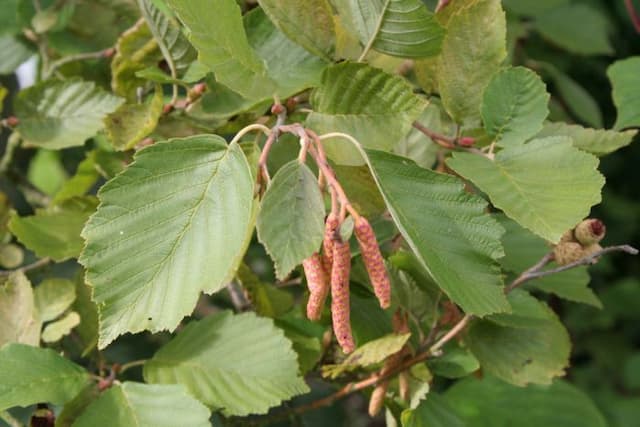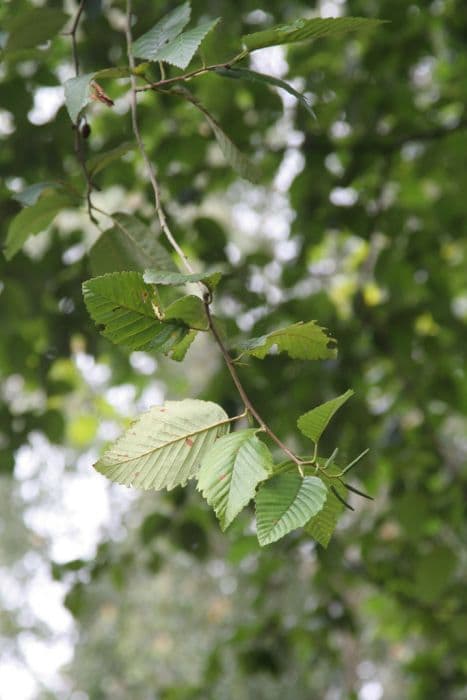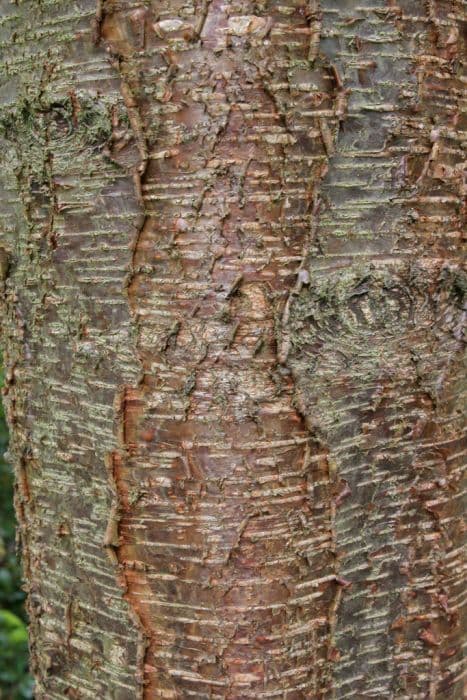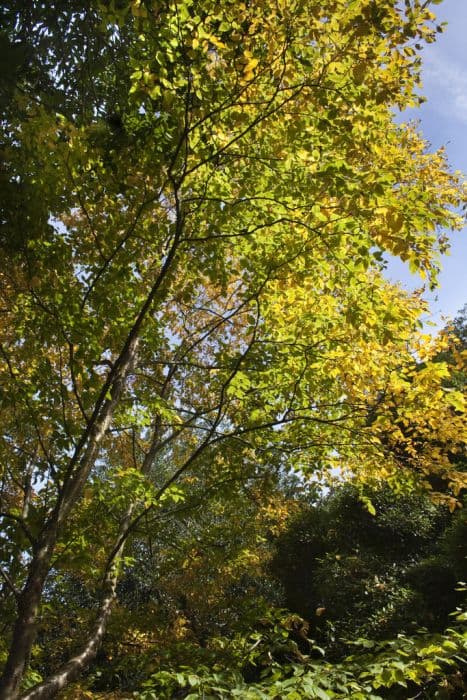Chinese Red Birch Betula utilis subsp. albosinensis 'Pink Champagne'

ABOUT
'Pink Champagne' is recognized for its distinctive bark which features an alluring mix of pink, white, and salmon patches that set it apart from other plants in a garden. This bark peels away in large sheets, revealing a smooth and shiny surface underneath that adds visual interest and texture. During the winter months, the starkness of the bark stands out even more against the landscape. The leaves are oval in shape and have a delicate, light green color, that contrasts nicely with the trunk. In the springtime, 'Pink Champagne' produces small flowers in the form of long and slender catkins, adding a soft decorative touch. Following the blooms, tiny winged seeds can emerge. The overall impression is that of a unique and visually striking specimen that enhances gardens with its year-round beauty.
About this plant
 Names
NamesFamily
Betulaceae
Synonyms
Chinese Red Birch, Pink Champagne Birch
Common names
Betula utilis var. albosinensis.
 Toxicity
ToxicityTo humans
The plant commonly known as Himalayan birch is not known to be toxic to humans. Therefore, there are no specific symptoms associated with poisoning from this plant, as it is generally considered safe in terms of human ingestion.
To pets
The plant commonly known as Himalayan birch is not considered toxic to pets. It is generally safe for animals, and there are no specific symptoms of poisoning associated with it for pets like cats and dogs.
 Characteristics
CharacteristicsLife cycle
Perennials
Foliage type
Deciduous
Color of leaves
Green
Height
20-30 feet (6-9 meters)
Spread
15-25 feet (4.5-7.5 meters)
Plant type
Tree
Hardiness zones
7
Native area
China
Benefits
 General Benefits
General Benefits- Ornamental Appeal: 'Pink Champagne' offers striking bark that peels away to reveal shades of pink, cream, and orange, making it a visually appealing addition to landscapes.
- Seasonal Interest: Produces catkins in the spring, which add early-season charm, followed by foliage that turns an attractive yellow in the fall.
- Habitat Support: Provides food and shelter for wildlife, such as birds and beneficial insects, due to its native characteristics.
- Drought Tolerance: Once established, it has a good tolerance to drought conditions, reducing the need for constant watering.
- Adaptability: This variety of birch can adapt to a variety of soils, although it prefers moist, well-drained conditions.
- Low-Maintenance: Requires minimal pruning compared to many ornamental trees, making it suitable for low-maintenance landscapes.
 Medical Properties
Medical PropertiesThis plant is not used for medical purposes.
 Air-purifying Qualities
Air-purifying QualitiesThis plant is not specifically known for air purifying qualities.
 Other Uses
Other Uses- Craft Material: The bark of Betula utilis, commonly known as Himalayan birch, can be used in crafting for its unique texture and color, adding a rustic touch to homemade crafts.
- Dye Production: The bark contains tannins that can be used to produce a light brown or orange dye for textiles
- Garden Ornamentation: Himalayan birch can be used as an ornamental feature in gardens, particularly 'Pink Champagne' with its attractive bark and foliage.
- Photography Subject: The distinctive appearance of its bark makes Himalayan birch a popular subject for nature photographers.
- Culinary Presentation: Thin sheets of its bark can serve as a natural platter or decorative element in gourmet presentations.
- Furniture Material: The wood of Himalayan birch is sometimes used in furniture making for its strength and pale color.
- Marquetry: The wood is utilized in the art of marquetry, where it is inlaid into veneer patterns for decorative effects on boxes and furniture.
- Educational Tool: Himalayan birch can be used in educational settings to teach about tree identification and the importance of biodiversity.
- Traditional Crafts: In some cultures, the flexible branches are used in traditional basket weaving or as framework for small structures.
- Landscape Design: With its attractive form and bark, it's used in landscape design to create focal points or to add winter interest in temperate climates.
Interesting Facts
 Feng Shui
Feng ShuiThe Himalayan Birch is not used in Feng Shui practice.
 Zodiac Sign Compitability
Zodiac Sign CompitabilityThe Himalayan Birch is not used in astrology practice.
 Plant Symbolism
Plant Symbolism- Adaptability: 'Pink Champagne' is a variety of birch tree known for its resilience and ability to adapt to different climates, symbolizing an individual's ability to weather changes in life.
- New Beginnings: Birch trees are often associated with new beginnings and renewal due to their fast growth, representing the start of a new chapter or fresh start in one's life.
- Purification: In various cultures, birch trees are linked to purification and cleaning, perhaps due to their bright bark and the way they shed layers, suggesting the shedding of old habits or influences for personal growth.
- Protection: Historically, birch wood has been used to make talismans intended to ward off evil, with the 'Pink Champagne' offering a unique twist to this traditional symbol of safeguarding.
- Hope: The light-colored bark and delicate leaves of the birch tree, including the 'Pink Champagne' variety, offer a symbol of hope and the promise of better times ahead, especially after a period of darkness.
 Water
WaterFor the Chinese Red Birch, it's important to water the plant regularly while it establishes roots, which generally takes one to two years. During this time, water the plant at least once a week with about 15-25 gallons, depending on the weather conditions. After establishment, they can tolerate some dry conditions but perform best with consistent moisture, so aim for around 10-15 gallons weekly during dry spells. During hot and dry periods, increase the frequency of watering to twice per week. It's crucial to avoid overwatering and ensure good drainage to prevent root rot.
 Light
LightThe Chinese Red Birch thrives best in full sun to partial shade conditions. The ideal spot is one where the plant receives at least four to six hours of direct sunlight daily, preferably during the morning. It can adapt to light shade, but too little light can lead to sparse foliage and reduced vigor. Ensure the plant is placed in a location that doesn't get too much afternoon sun, which can be too intense.
 Temperature
TemperatureThe Chinese Red Birch is hardy and can tolerate a wide range of temperatures. It can survive minimum temperatures down to -30°F, but the ideal growing conditions are between 40°F to 70°F. It is best to avoid exposure to temperatures above 80°F for extended periods because excessive heat can stress the tree.
 Pruning
PruningThe Chinese Red Birch should be pruned to remove any dead, broken, or diseased branches, which can be done at any time of the year. Structural pruning to shape the tree or to remove crossed branches is best done during the dormant season, in late fall or winter. It is not necessary to prune annually, but periodic thinning every three to five years can help maintain the tree's health and appearance.
 Cleaning
CleaningAs needed
 Soil
SoilChinese Red Birch, or 'Pink Champagne', thrives in moist, well-draining soil with a slightly acidic to neutral pH of 6.5-7.5. Best soil mix can be prepared with two parts loam, one part peat moss or leaf mold, and one part sharp sand or perlite for drainage.
 Repotting
RepottingChinese Red Birch doesn't often require repotting as it is typically grown as a landscape tree. If container-grown, young trees may need repotting every two to three years until they reach maturity.
 Humidity & Misting
Humidity & MistingChinese Red Birch prefers a moderate level of humidity. While it can tolerate some level of variation, excessive dry air can lead to leaf problems. Aim for an average humidity level conducive to a temperate, outdoor environment.
 Suitable locations
Suitable locationsIndoor
Ensure bright light, cool temps, and occasional misting.
Outdoor
Plant in full sun to partial shade, shelter from strong winds.
Hardiness zone
7-9 USDA
 Life cycle
Life cycleBetula utilis subsp. albosinensis 'Pink Champagne', commonly known as Pink Champagne Birch, begins its life cycle as a seed, which upon germination, develops into a small seedling. The seedling grows through a vegetative stage, wherein it establishes a root system and begins to produce its characteristic leaves and pink-tinged bark. As it enters the sapling stage, it continues to increase in height and girth, gradually maturing over several years into a fully grown tree capable of reproduction. During spring, the mature Pink Champagne Birch produces catkins, which after pollination, develop into seeds, thus completing the reproductive stage. Seasonally, the tree undergoes periods of growth and dormancy, with leaves emerging in spring, flourishing through summer, and then being shed in the autumn. After many years, the tree reaches the end of its life cycle and will eventually die, often leaving behind seeds that will give rise to future generations.
 Propogation
PropogationPropogation time
Spring-Early Summer
The Betula utilis var. 'Pink Champagne', commonly known as the Chinese Red Birch, is it best propagated by taking root cuttings during the dormant season, typically in late fall to mid-winter. To propagate, one would take 2 to 4-inch (5 to 10 cm) sections of young roots, ideally the thickness of a pencil. These cuttings should be placed horizontally in a potting medium and kept at a consistent moisture level. It is important to care for the cuttings in a cool environment until they begin to sprout in the spring, at which point they can eventually be transplanted outdoors once the threat of frost has passed and they've developed a sturdy root system.









